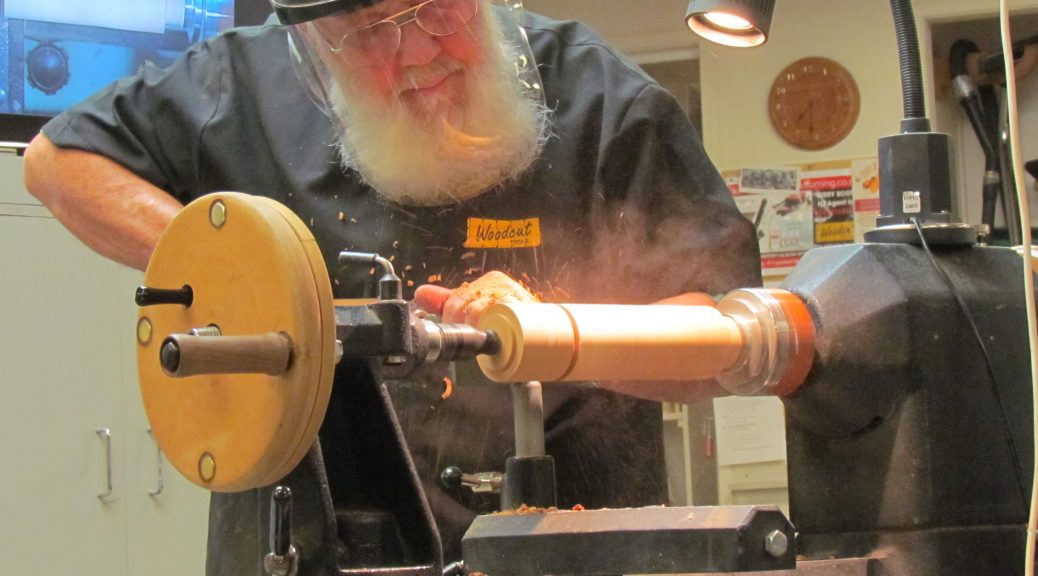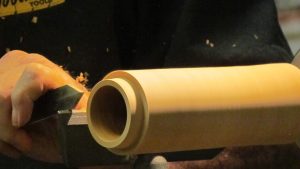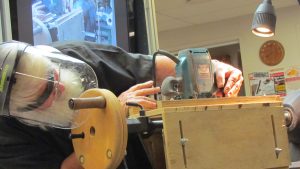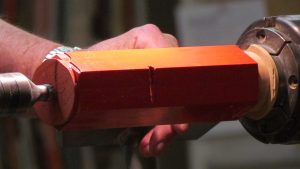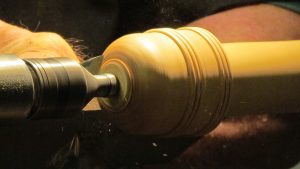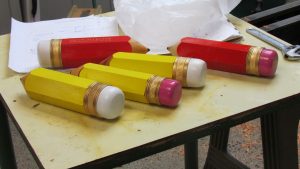Club Meeting: 5 Dec 2018
Report by Graeme Mackay
Dick’s pencil boxes demonstration: This exercise was taken from an AAW project that was based on Beth Ireland’s boxes. The process is that the box making system ends up with a pencil looking like a pencil case. Dick started the demo with a history of lead pencils i.e. those with graphite in them in. Then a discourse about the colours that pencils came in.
The base: A cylinder, about 200 mm long is made with two jam chucks it is cleaned and then a parting is taken around 60 mm from one end.
A Dick V tip: When parting off a piece, remember to keep the gap and do not let the tool jam.
The next process is started with hollowing by way of Forstner bit or bits if you are precise. A piece of measured tape on Forstner bit provides a depth check. The second Forstner bit opens the hole further. The second part of the hole is continued with an extension on the Jacobs chuck.
Another Dick B tip: keep to speed down when using Forstner bit and check the actual width of the piece.
The lip at the top of the long section allows for fitting the pencil top onto the box base. Remember, the lip on the box head is made to fit the base lip. Similarly, a hole check on box top depth is required. Measure and make the lip fit in a close manner and this is done while leaving the box top in the chuck.
The pencil faces: Dick brought out his cleverly fashioned jig. A boxlike structure that is attached to the frame of the lathe. After some adjustment, fiddling, shifting around, the Router was used to clean off the six faces of the pencil. Some measuring and judging is required. The box is relatively simple and is technically only a guide for the router. It is simply one of the ways in producing the six sides of the pencil – all hopefully matched even and appropriate looking.
Back to the top i.e. the sharp end that that has imitation graphite in it. The lip is mark with Vernier callipers and cut down with a standard skew. It is hoped that you have remembered to leave sufficient thickness to accommodate the flat faces and that they join into a new top.
The finishing touch: The bead lines highlight the end of the pencil in the piece that holds your eraser. Texturing highlights these beads provides a differentiation to the pencil part and hopefully shows up in its glory, with some clean edges. This part of the process is achieved by putting the top of the box/pencil case onto a cylinder mandrel. Holding the box top on with the stem centres will assist safety and avoid any mishaps.
Colouring helps highlight faces, eraser frame and eraser itself. The sharp end of the pen is highlighted by colour or even just a dark felt -tip.
This is a standard box process with some interesting features. The avoiding confusion is easy, just go onto the site, and follow the box making plan.
Tip
The best tip once you enter this process is
measure, measure again, and check that measurement.
Graeme Mackay
December 2018
